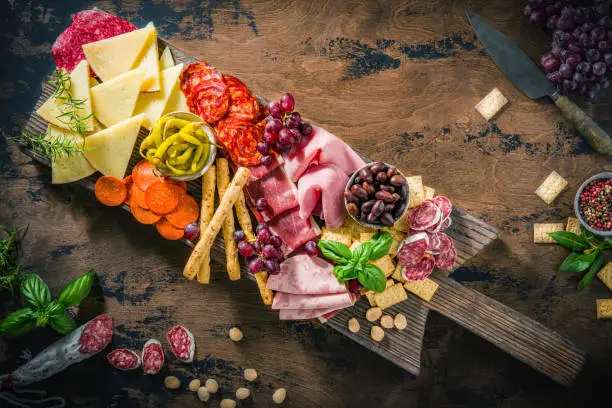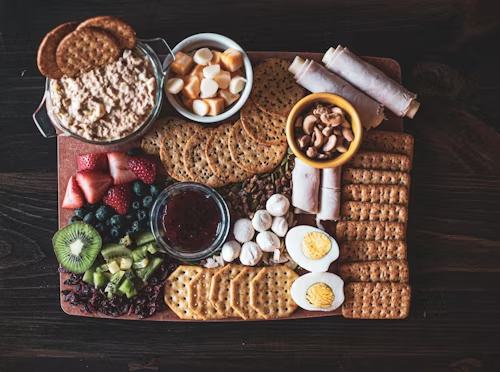
Charcuterie, a French term that literally translates to “cooked flesh,” refers to the art of preparing and preserving meats through various methods such as curing, smoking, and fermenting. Though historically a way to preserve meats before refrigeration, charcuterie has evolved into a sophisticated and visually appealing food trend that has taken over dinner parties, gatherings, and restaurant menus worldwide. Whether it’s served on a wooden board or artfully arranged with accompaniments like cheeses, fruits, nuts, and spreads, charcuterie offers a unique combination of flavors, textures, and experiences that make it a favorite for many food lovers.
1. The History of Charcuterie
The origins of charcuterie trace back to ancient times, but it was in France, during the 15th and 16th centuries, that it truly became an art form. In medieval Europe, preserving meat was essential for survival, especially before refrigeration. Curing, salting, smoking, and drying were common techniques used to extend the shelf life of meats, allowing them to be stored for long periods and eaten throughout the year.
Initially, charcuterie was a practical necessity for households and farmers, often made using leftover cuts of meat such as pork. Over time, these methods of preservation developed into a refined craft, with artisans becoming skilled at crafting unique and flavorful cured meats. In modern times, charcuterie has evolved from its utilitarian beginnings to become a luxurious and indulgent centerpiece in culinary culture, celebrated for its flavors, textures, and artistic presentation.
2. The Components of a Classic Charcuterie Board
A traditional charcuterie board is not only a feast for the palate but also for the eyes. The arrangement and balance of flavors, colors, and textures are essential to creating the perfect charcuterie experience. Here are the main components typically found on a charcuterie board:
Cured Meats
The heart of any charcuterie board is its selection of meats, often a combination of rich, salty, and savory flavors. Common choices include:
- Prosciutto: A delicate, thinly sliced Italian dry-cured ham with a sweet, salty flavor.
- Salami: A type of cured sausage, usually made from fermented and air-dried meats like pork or beef, and often flavored with spices like garlic, fennel, or peppercorns.
- Chorizo: A Spanish or Mexican sausage made from pork and seasoned with paprika and garlic. It can be either cured or fresh, and its smoky flavor is a popular addition to charcuterie.
- Bresaola: An air-dried, salted beef from Italy, usually served in thin slices, offering a tender texture and slightly sweet flavor.
- Soppressata: An Italian dry salami made from pork and flavored with red pepper flakes and garlic, giving it a spicy kick.
Cheese
Cheese is a crucial accompaniment to charcuterie, with a variety of textures and flavors that balance the richness of the meats. Some popular choices include:
- Brie: A creamy, soft cheese from France with a delicate, buttery flavor.
- Manchego: A firm Spanish cheese made from sheep’s milk, often aged to develop a nutty, savory flavor.
- Aged Cheddar: A sharp, tangy cheese that complements the saltiness of cured meats.
- Goat Cheese: Soft, tangy cheese that pairs well with both fresh and cured meats.
- Gorgonzola: A blue-veined cheese that provides a bold, pungent contrast to the milder flavors on the board.
Accompaniments
The accompaniments to charcuterie are just as important as the meats and cheeses themselves. These additions enhance the flavors and add contrast to the richness of the cured meats and cheeses. Common accompaniments include:
- Bread and Crackers: Sliced baguettes, crusty bread, or a variety of crackers provide a neutral base to balance out the rich flavors of the meats and cheeses.
- Fruits: Fresh fruits such as grapes, apples, or figs offer sweetness and freshness that contrast nicely with the salty meats and creamy cheeses.
- Nuts: Almonds, walnuts, or pistachios add a crunchy texture and a slightly bitter flavor that enhances the overall experience.
- Pickles and Olives: The tanginess of pickled vegetables or olives provides a much-needed contrast to the richness of the charcuterie, cutting through the fat with their acidity.
- Jams and Honey: A sweet spread, such as fig jam or honey, can help balance the saltiness of the meats and offer a contrasting flavor profile.
3. Assembling the Perfect Charcuterie Board
Creating an aesthetically pleasing and well-balanced charcuterie board requires a bit of thought and attention to detail. Here’s a simple guide to assembling one:
- Choose a Base: Start with a large wooden board, marble slab, or a tray as your foundation. You want a surface that allows for plenty of room to arrange the different components.
- Add the Meats: Begin by arranging the cured meats in overlapping slices or folds, ensuring they’re spread out evenly. Grouping similar meats together can create a sense of variety and balance.
- Arrange the Cheese: Place the cheeses in separate sections of the board, ensuring there’s a variety of textures—some soft, some hard, and some creamy. If the cheeses have a rind, such as Brie or Gorgonzola, be sure to slice them so guests can easily serve themselves.
- Fill in with Accompaniments: Add the pickles, olives, and jams in small bowls or directly on the board. Scatter the nuts and fruits around the board to fill in the gaps and add vibrant color.
- Consider Garnishes: Fresh herbs like rosemary or thyme, edible flowers, or additional slices of fruit can be used as garnishes to enhance the visual appeal of the board.
- Serve with Drinks: Charcuterie pairs beautifully with a variety of drinks. A good wine is a classic choice—red wines like Cabernet Sauvignon or Pinot Noir, and white wines like Chardonnay or Sauvignon Blanc, complement the rich flavors of the meats and cheeses. Beer, cider, or even a cocktail can also be great options, depending on your guests’ preferences.
4. Charcuterie Around the World
While the term “charcuterie” is most closely associated with French cuisine, variations of cured meats and preserved meat dishes can be found around the globe:
- Spain: Spain is famous for its jamón ibérico, a high-quality cured ham, and chorizo, a spicy sausage. These meats are often served with olives, bread, and a glass of wine or sherry.
- Italy: Italy offers a wide variety of cured meats like salami, prosciutto, and mortadella, which are commonly paired with cheeses such as mozzarella and Parmigiano-Reggiano.
- Germany: Known for its sauerkraut and sausages, Germany’s charcuterie offerings often include smoked sausages like bratwurst or landjäger, along with hearty breads and pickles.
- Argentina: In Argentina, empanadas and choripán (sausage sandwiches) are common accompaniments to meats and cheeses, providing a flavorful take on charcuterie with a South American twist.
5. Modern Charcuterie Trends
Charcuterie boards have evolved to include not only traditional meats but also a variety of creative, modern twists. Some contemporary trends include:
- Vegan Charcuterie: This plant-based version uses meat substitutes like vegan cheeses, hummus, roasted vegetables, and marinated tofu or tempeh to recreate the flavors and textures of a traditional charcuterie board.
- Sweet Charcuterie: A dessert-oriented charcuterie board that focuses on sweet treats such as chocolates, cookies, marshmallows, fruit preserves, and pastries. This is perfect for those with a sweet tooth.
- Themed Boards: From seasonal offerings (think fall-themed boards with pumpkin and apples) to international-inspired boards (like Mediterranean or Asian charcuterie), people are getting creative with the ingredients they include on their boards.

Charcuterie is more than just a collection of cured meats; it’s a celebration of flavor, craftsmanship, and creativity. Whether you’re putting together a simple board for a cozy evening or crafting an elaborate spread for a special occasion, charcuterie offers endless possibilities for combination, presentation, and enjoyment. With its rich history, versatile components, and ability to cater to various dietary preferences, charcuterie continues to captivate food lovers around the world, making it a timeless and indulgent culinary tradition.

